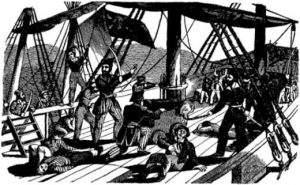For three hundred years, beginning in the ninth century, they sailed the known world and discovered lands beyond their maps.1 They pillaged the peoples of England and France, canals along Middle Eastern coasts, and even their own Scandinavia, venturing as far as the east coast of North America. Being given names, such as pirates, barbarians, monsters, and farmers, today we know them as Vikings. Their people did not fear death in combat, and they would go to great lengths to find a worthy way to die. Being killed heroically with a weapon in hand could get the attention of a Valkyrie, or angelic female warrior, to determine if ones death was worthy. If deemed worthy one would ascend to Valhalla, the Nordic afterlife for a warrior, where one would brag about one’s adventures and fight to the death daily in the army of Oden, chieftain of the Norse gods, as preparation for the end of the world. One man that stood out among these hardened people and became one of the first Scandinavian kings was Ragnar Lothbrok.2
Being born just before the turn of the year 800 CE, Ragnar Lothbrok brought together the Scandinavian war bands under his command. With Europe poorly protected, and with Charlemagne’s rule coming to an end, Ragnar took the advantage and led his Vikings on many campaigns to loot Europe of its treasures.3 With little real knowledge of the Norsemen, the peoplesand treasures of Europe were easy targets. When in the fighting line, Ragnar was said to dwarf his companions that stood around him and fought in his armies as a berserker.4 A berserker is a warrior that fights in a rage-filled trance, being able to take on multiple injuries before falling in battle. Ragnar was admired for his skills in battle and for his strategic mind. His armies could hold their own against Charlemagne’s forces due to his strategic cunning. Ragnar is even father to other well-known Viking warriors, Bijorn Ironside, Hubb, and Ivar the Boneless, a figure of terror in Irish and English storytelling.5

The untimely demise of Ragnar Lothbrok became a story of revenge. With so many battles and victories against the Anglo Saxons, Ragnar had created enemy in Aelle, ruler of York. During Ragnar’s last battle, he was captured by the Anglo Saxons and became a prisoner. In honor of his new prisoner, Aelle, ruler of York, ordered his men to build a pit of snakes for Ragnar to be thrown into. As the snake venom was running through Ragnar’s veins, he is reported to have uttered, as his last words, “How the little pigs will grunt when they hear how the old boar has died,” referring to his sons as the avengers of his death.6 The death of Ragnar Lothbrok supposedly triggered a new age of Viking attacks. Those attacks had the ferocity and intensity that Vikings later became known for. Seeking to avenge their father’s death, Ivar the Boneless and his two brothers led their Viking forces to East Anglia in 865 CE. In the name of revenge, the brothers captured Aelle and killed him with the rite of the blood eagle.7 This rite was a gruesome and painful form of execution by torture that resulted in a slow death; after the torture, the poor soul subjected to the rite was to be tied by the wrists in the air to two separate trees, to resemble a bird in flight, to honor Oden’s sacred bird, the eagle. The ritual was so gruesome that it was hardly ever used and only on those deserving of it.

The story of Ragnar Lothbrok became a legend and was written into the Icelandic sagas and the Gesta Danorum.8 Over time he became another epic hero in a story with impossible adventures. Between the seventh and ninth centuries, multiple stories and lives of other people named Ragnar have surfaced. Despite these multiple stories, there will only be a true original Ragnar Lothbrok, the one that forced his way into history and built the reputation of the Vikings.
- Gale Encyclopedia of World History, 2008, s.v. “Viking Raids and Norman Conquests (8th to 11th Centuries).” ↵
- P.D. Kirby, “Review of A.P. Smyth’s Scandinavian Kings in the British Isles 850-880,” The English Historical Review 94, no. 370 (January 1979): 162-163. ↵
- P.D. Kirby, “Review of A.P. Smyth’s Scandinavian Kings in the British Isles 850-880,” The English Historical Review 94, no. 370 (January 1979): 162-163. ↵
- Gale Encyclopedia of World History, 2008, s.v. “Viking Raids and Norman Conquests (8th to 11th Centuries).” ↵
- Encyclopedia of the Barbarian World, 2004, s.v. “Bronze Age to Early Middle Ages,” by Peter Bogucki and Pam J. Crabtree. ↵
- Encyclopedia of the Barbarian World, 2004, s.v. “Bronze Age to Early Middle Ages,” by Peter Bogucki and Pam J. Crabtree. ↵
- Roberta Frank, “Viking Atrocity and Skaldic Verse: The Rite of the Blood Eagle.” The English Historical Review 99, no. 391 (April 1984):332-343. ↵
- Neil Schlager and Josh Lauer, Science and Its Times (Detroit: Gale, 2001), 100-101. ↵



50 comments
Esperanza Rojas
This was a really captivating article. It had all the information and the story line was told wonderfully. The vikings have always been a topic of interest for me but I never really read into it. Reading this story was interesting to learn that Ragnor was someone that followed his people’s beliefs and from that he gained their admiration. Because of his loyalty to his people, they repaid him by avenging him.
Sebastian Carnero
A great strategic that fight as a berserker is something pretty rare. When a leader fight to the side of his army, all of them have their morale boosted and will fight until victory or death. And even more willing when they considered dying while wearing a weapon an honor. Even in his last moments, he kept fighting, he fought with words by insulting Anglo Saxons. An army without fear must be something really dangerous. I also find pretty interesting their concept of heaven: Entering if worthy and fighting every day.
Annissa Noblejas
The Viking religious implications of dying well most likely influenced their aggressive combative lifestyle. Not much of their territory was good farming lands, another possible motive for seasonal raiding. It is no easy feat to unite multiple war bands and bring them together, so Ragnar must have been both a skilled warrior and influential leader. Certainly, a man whose death would have been violently avenged tenfold.
Timothy ODekirk
This was an interesting article indeed. I never seen the show, “Vikings” but I find it interesting how it was based on a true historic account. I like the name, Ragnar, and the story about him was highly fascinating as well. I like the story of vengange and the story written here is smooth and very intriguing. This was a great article and a highly interesting story about Ragnar the Viking.
Maria Esquivel
I don’t know much about Vikings or the way they fought so it was really interesting to learn about them and Ragnar Lothbrok. What a horrible death Ragnar had to undergo, but at least his bravery and loyalty will always be honored and remembered. He did great things for his people and now he is in Valhalla. I am actually really interested to learn more about Ragnar so I am glad you provided in your images that there is a film inspired by him, I look forward to seeing it.
Caroline Bush
Loved this article, I have always been interested in Viking culture and that way you wrote about it was perfect. The Vikings are interesting in the sense that they sailed around and took what they wanted but also their extreme loyalty to their leader. The story of Ragnar was interesting and I can tell that you put a lot of effort into your research. Overall I really enjoyed this article and found the story very interesting.
Natalie Childs
This article was really well written and kept me interested the whole way through. While I have known some about Vikings, but from brief stories in my western civ one, I never knew much about Ragnar Lothbrok. He really seems to have gone above and beyond for his people, and inspired many that followed him. The fact that he became the stuff of myth and legends as he has, really shows just how impactful he really was.
Tyler Thompson
This article shows that loyalty to authority goes a long way. The author did a good job describing the importance of Nobel deaths in the eyes of Vikings. It was very interesting, I enjoyed reading about Ragnar, and how he is of high status. It was also interesting to read about how they took revenge on the man who killed Ragnar.
Destiny Flores
I don’t know much about vikings at all. This story is really interesting and before I read this, I had never heard of Ragnor Lothbrok. The little bit that I do know about vikings is the hostility of them. I also did not know that they had such strong beliefs in Gods and what their motives were behind their fighting.
Brandon Martinez
The Vikings are a people that not many people know about. This article uncovers the story of a Viking legend and gives insight into the way of life for these people. The Vikings were one of the most fearsome and brutal people to ever live on the earth, but this article contrasts that and gives the explanation that Vikings were not just brutal people, but also ones that lives their life in honor of their gods.